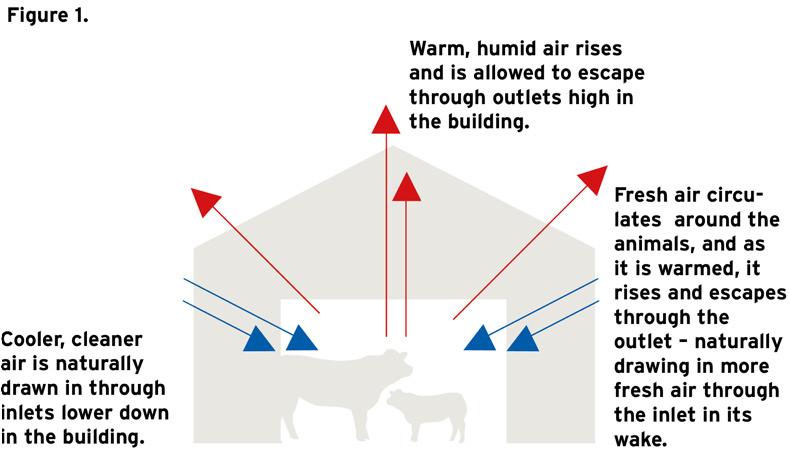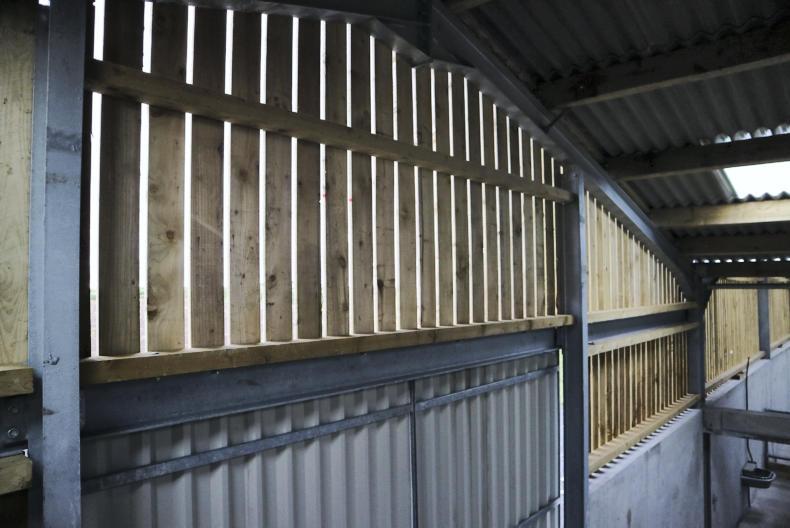At Tuesday’s BETTER farm beef challenge technical day in Grange, the focus was placed on herd health, particularly in the build-up to housing.
Farmers were unanimous in saying that pneumonia is one of their biggest health concerns during the housing period.
The three vets present on the day, Maria Guelbenzu and Natascha Munier of AHI and Journal vet Tommy Heffernan agreed that one of the main causes of pneumonia problems is poor ventilation.
They advised farmers to really study ventilation in their sheds over the coming days, prior to housing.
Natural disinfectant
Housed animals need to be able to breathe in fresh clean air to thrive and remain healthy.
The availability of this fresh clean air is dependent on the effectiveness of the ventilation in the shed. Good ventilation supplies enough clean air to remove gasses, odours, dust, bacteria and removes heat and moisture generated by the animals housed.
Air actually deactivates the virus
Fresh air is actually a disinfectant, if a virus is coughed up in a building, it will last for 20 hours. However, if the same virus is coughed up outside in fresh air, it will last for about 20 minutes.
Air actually deactivates the virus and we need to make maximum use of fresh air in sheds. To check if you have an issue, you need to observe the conditions in the shed before housing and at housing.
When you enter a shed and look up, you should not see cobwebs, condensation and/or rust damage on the walls/roof or blackened timber.
The shed should not be warm and stuffy or smell of ammonia. If you see these present it means there is not enough air circulating through that shed.
In Ireland, natural ventilation is the preferred method of ventilation of livestock housing and this is dependent on the inlets and outlets in the shed being big enough for the number and size of the stock being housed. The stack effect is the main theory here,
Stack effect
The stack effect is driven by the heat produced by the animals. The animals produce heat and warm the air.
The warm air rises, escapes through the outlet area (highest point of the house) and is replaced by clean fresh air through the inlet area (Figure 1).

If there is no outlet available or the outlet is too small, the air will cool down and come back down on the animals. This air will be moist and almost certainly carry harmful bugs, which have been proven to cause ill health and respiratory problems.
If the inlets are too small, this air is slow to come in and helps push out the warm air reducing the airflow.
So the rate of ventilation is influenced by the size of the inlet and outlets. However, it is also influenced by the roof pitch and the height difference between inlets and outlets, the height of the eaves and the proximity or interference from other buildings.
Ideally cattle sheds should be sited with the side at right angles to the prevailing wind. However, open-sided buildings should be orientated with the open side sheltered from the prevailing wind.

Spaced boarding.
Dealing with issues
Inlet
Angle out the side cladding, at the bottom. Moving out the side cladding to leave a clear opening between the side wall of the shed and the side cladding, just below the top of the side wall, will provide a good inlet. Air is deflected upwards from the side wall as it enters. This can be done easily enough with box section steel. The box section will make it is secure and will allow the gap width to be maximised.Where sheds have a wall built right up, the easiest solution is to knock off a few lines of blocks to provide a continuous opening. Monitor how it works to see if any more needs to be done.Replace side sheeting with vented sheeting, space boarding, Yorkshire boarding or a windbreaker.Remove any trees, hedges or other obstacles blocking wind from the side of the shed.Outlet
Raise the ridge cap if possible.Spaced sheeting in the roof is excellent, but really not practical unless all the sheeting is being replaced Raising sheets is a practical method to turn the roof into a “breathing roof”. One or two lines of sheeting per bay can be raised above the plane of the roof by about 100 mm to 150 mm with an overlap of about 100 mm to 150 mm, at each side, to prevent in-blown rain. The raised sheets run up along the slope of the roof (which is usually across the width of the shed) and possibly up and over a round-roofed shed, as well, if one is present. The size of the outlet can be calculated by multiplying the total length of all the openings by the raised height and comparing them to the guidelines.Other considerations
Draughts are just as bad, if not worse, than poor air movement and stuffy conditions. Doors left open continuously are just as bad as a shed with no doors. Doors should not be used to provide extra inlet or outlet area. Doors may be opened in mild/warm weather to supplement ventilation as long as they don’t cause draughts. Doors used to supplement inadequate ventilation will lead to draughts.
Light is also very important in animal housing, mainly for the animals, but also for the person looking after and observing them. Any improvements to natural light that can be made in conjunction with making improvements in ventilation should be availed of.
At Tuesday’s BETTER farm beef challenge technical day in Grange, the focus was placed on herd health, particularly in the build-up to housing.
Farmers were unanimous in saying that pneumonia is one of their biggest health concerns during the housing period.
The three vets present on the day, Maria Guelbenzu and Natascha Munier of AHI and Journal vet Tommy Heffernan agreed that one of the main causes of pneumonia problems is poor ventilation.
They advised farmers to really study ventilation in their sheds over the coming days, prior to housing.
Natural disinfectant
Housed animals need to be able to breathe in fresh clean air to thrive and remain healthy.
The availability of this fresh clean air is dependent on the effectiveness of the ventilation in the shed. Good ventilation supplies enough clean air to remove gasses, odours, dust, bacteria and removes heat and moisture generated by the animals housed.
Air actually deactivates the virus
Fresh air is actually a disinfectant, if a virus is coughed up in a building, it will last for 20 hours. However, if the same virus is coughed up outside in fresh air, it will last for about 20 minutes.
Air actually deactivates the virus and we need to make maximum use of fresh air in sheds. To check if you have an issue, you need to observe the conditions in the shed before housing and at housing.
When you enter a shed and look up, you should not see cobwebs, condensation and/or rust damage on the walls/roof or blackened timber.
The shed should not be warm and stuffy or smell of ammonia. If you see these present it means there is not enough air circulating through that shed.
In Ireland, natural ventilation is the preferred method of ventilation of livestock housing and this is dependent on the inlets and outlets in the shed being big enough for the number and size of the stock being housed. The stack effect is the main theory here,
Stack effect
The stack effect is driven by the heat produced by the animals. The animals produce heat and warm the air.
The warm air rises, escapes through the outlet area (highest point of the house) and is replaced by clean fresh air through the inlet area (Figure 1).

If there is no outlet available or the outlet is too small, the air will cool down and come back down on the animals. This air will be moist and almost certainly carry harmful bugs, which have been proven to cause ill health and respiratory problems.
If the inlets are too small, this air is slow to come in and helps push out the warm air reducing the airflow.
So the rate of ventilation is influenced by the size of the inlet and outlets. However, it is also influenced by the roof pitch and the height difference between inlets and outlets, the height of the eaves and the proximity or interference from other buildings.
Ideally cattle sheds should be sited with the side at right angles to the prevailing wind. However, open-sided buildings should be orientated with the open side sheltered from the prevailing wind.

Spaced boarding.
Dealing with issues
Inlet
Angle out the side cladding, at the bottom. Moving out the side cladding to leave a clear opening between the side wall of the shed and the side cladding, just below the top of the side wall, will provide a good inlet. Air is deflected upwards from the side wall as it enters. This can be done easily enough with box section steel. The box section will make it is secure and will allow the gap width to be maximised.Where sheds have a wall built right up, the easiest solution is to knock off a few lines of blocks to provide a continuous opening. Monitor how it works to see if any more needs to be done.Replace side sheeting with vented sheeting, space boarding, Yorkshire boarding or a windbreaker.Remove any trees, hedges or other obstacles blocking wind from the side of the shed.Outlet
Raise the ridge cap if possible.Spaced sheeting in the roof is excellent, but really not practical unless all the sheeting is being replaced Raising sheets is a practical method to turn the roof into a “breathing roof”. One or two lines of sheeting per bay can be raised above the plane of the roof by about 100 mm to 150 mm with an overlap of about 100 mm to 150 mm, at each side, to prevent in-blown rain. The raised sheets run up along the slope of the roof (which is usually across the width of the shed) and possibly up and over a round-roofed shed, as well, if one is present. The size of the outlet can be calculated by multiplying the total length of all the openings by the raised height and comparing them to the guidelines.Other considerations
Draughts are just as bad, if not worse, than poor air movement and stuffy conditions. Doors left open continuously are just as bad as a shed with no doors. Doors should not be used to provide extra inlet or outlet area. Doors may be opened in mild/warm weather to supplement ventilation as long as they don’t cause draughts. Doors used to supplement inadequate ventilation will lead to draughts.
Light is also very important in animal housing, mainly for the animals, but also for the person looking after and observing them. Any improvements to natural light that can be made in conjunction with making improvements in ventilation should be availed of.








 This is a subscriber-only article
This is a subscriber-only article









SHARING OPTIONS: